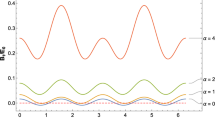Abstract
We present a family of easily computable upper bounds for the Holevo (information) quantity of an ensemble of quantum states depending on a reference state (as a free parameter). These upper bounds are obtained by combining probabilistic and metric characteristics of the ensemble. We show that an appropriate choice of the reference state gives tight upper bounds for the Holevo quantity which in many cases improve the estimates existing in the literature. We also present an upper bound for the Holevo quantity of a generalized ensemble of quantum states with finite average energy depending on the metric divergence of an ensemble. In the case of a multi-mode quantum oscillator, this upper bound is tight for large energy. Upper bounds for the Holevo capacity of finite-dimensional quantum channels depending on metric characteristics of the channel output are obtained.
Similar content being viewed by others
References
Holevo, A.S., Bounds for the Quantity of Information Transmitted by a Quantum Communication Channel, Probl. Peredachi Inf., 1973, vol. 9, no. 3, pp. 3–11 [Probl. Inf. Transm. (Engl. Transl.), 1973, vol. 9, no. 3, pp. 177-183].
Holevo, A.S., Kvantovye sistemy, kanaly, informatsiya, Moscow: MCCME, 2010. Translated under the title Quantum Systems, Channels, Information: A Mathematical Introduction, Berlin: de Gruyter, 2012.
Nielsen, M.A. and Chuang, I.L., Quantum Computation and Quantum Information, Cambridge: Cambridge Univ. Press, 2000. Translated under the title Kvantovye vychisleniya i kvantovaya informatsiya, Moscow: Mir, 2006.
Wilde, M.M., Quantum Information Theory, Cambridge, UK: Cambridge Univ. Press, 2013.
Audenaert, K.M.R., Quantum Skew Divergence, J. Math. Phys., 2014, vol. 55, no. 11, p. 112202 (21 pp.).
Briët, J. and Harremoës, P., Properties of Classical and Quantum Jensen-Shannon Divergence, Phys. Rev. A, 2009, vol. 79, no. 5, p. 052311.
Fannes, M., de Melo, F., Roga, W., and Życzkowski, K., Matrices of Fidelities for Ensembles of Quantum States and the Holevo Quantity, Quantum Inf. Comput., 2012, vol. 12, no. 5–6, pp. 472–489.
Roga, W., Fannes, M., and Życzkowski, K., Universal Bounds for the Holevo Quantity, Coherent Information, and the Jensen-Shannon Divergence, Phys. Rev. Lett., 2010, vol. 105, no. 4, p. 040505 (4 pp.).
Zhang, L., Wu, J., and Fei, S.-M., Universal Upper Bound for the Holevo Information Induced by a Quantum Operation, Phys. Lett. A, 2012, vol. 376, no. 47–48, pp. 3588–3592.
Alicki, R. and Fannes, M., Continuity of Quantum Conditional Information, J. Phys. A: Math. Gen., 2004, vol. 37, no. 5, pp. L55–L57.
Winter, A., Tight Uniform Continuity Bounds for Quantum Entropies: Conditional Entropy, Relative Entropy Distance and Energy Constraints, Comm. Math. Phys., 2016, vol. 347, no. 1, pp. 291–313.
Lindblad, G., Expectation and Entropy Inequalities for Finite Quantum Systems, Comm. Math. Phys., 1974, vol. 39, no. 2, pp. 111–119.
Ohya, M. and Petz, D., Quantum Entropy and Its Use, Berlin: Springer, 1993.
Donald, M.J., Further Results on the Relative Entropy, Math. Proc. Cambridge Philos. Soc., 1987, vol. 101, no. 2, pp. 363–373.
Shirokov, M.E., Tight Uniform Continuity Bounds for the Quantum Conditional Mutual Information, for the Holevo Quantity, and for Capacities of Quantum Channels, J. Math. Phys., 2017, vol. 58, no. 10, p. 102202 (29 pp.).
Holevo, A.S. and Shirokov, M.E., Continuous Ensembles and the Capacity of Infinite-Dimensional Quantum Channels, Teor. Veroyatnost. i Primenen., 2005, vol. 50, no. 1, pp. 98–114 [Theory Probab. Appl. (Engl. Transl.), 2006, vol. 50, no. 1, pp. 86-98].
Shirokov, M.E., Entropy Characteristics of Subsets of States. I, Izv. Ross. Akad. Nauk, Ser. Mat., 2006, vol. 70, no. 6, pp. 193–222 [Izv. Math. (Engl. Transl.), 2006, vol. 70, no. 6, pp. 1265-1292].
Wehrl, A., General Properties of Entropy, Rev. Mod. Phys., 1978, vol. 50, no. 2, pp. 221–260.
Wang, X., Xie, W., and Duan, R., Semidefinite Programming Strong Converse Bounds for Classical Capacity, IEEE Trans. Inform. Theory, 2018, vol. 64, no. 1, pp. 640–653.
Leditzky, F., Kaur, E., Datta, N., and Wilde, M.M., Approaches for Approximate Additivity of the Holevo Information of Quantum Channels, Phys. Rev. A, 2018, vol. 97, no. 1, p. 012332.
Filippov, S.N., Lower and Upper Bounds on Nonunital Qubit Channel Capacities, Rep. Math. Phys., 2018, vol. 82, no. 2, pp. 149–159.
Amir, D. and Ziegler, Z., Relative Chebyshev Centers in Normed Linear Spaces. I, J. Approx. Theory, 1980, vol. 29, no. 3, pp. 235–252.
Garkavi, A.L., On the Chebyshev Center and Convex Hull of a Set, Uspekhi Mat. Nauk, 1964, vol. 19, no. 6 (120), pp. 139–145.
Amosov, G.G., Strong Superadditivity Conjecture Holds for the Quantum Depolarizing Channel in Any Dimension, Phys. Rev. A, 2007, vol. 75, no. 6, p. 060304(R) (2 pp.).
King, C., The Capacity of the Quantum Depolarizing Channel, IEEE Trans. Inform. Theory, 2003, vol. 49, no. 1, pp. 221–229.
Amosov, G.G. and Mancini, S., The Decreasing Property of Relative Entropy and the Strong Superad-ditivity of Quantum Channels, Quantum Inf. Comput., 2009, vol. 9, no. 7–8, pp. 594–609.
Amosov, G.G., On Weyl Channels Being Covariant with Respect to the Maximum Commutative Group of Unitaries, J. Math. Phys., 2007, vol. 48, no. 1, p. 012104 (14 pp.).
Funding
The research was carried out at the expense of the Russian Science Foundation, project no. 19-11-00086.
Author information
Authors and Affiliations
Corresponding author
Additional information
Russian Text © The Author(s), 2019, published in Problemy Peredachi Informatsii, 2019, Vol. 55, No. 3, pp. 3–20.
Rights and permissions
About this article
Cite this article
Shirokov, M.E. Upper Bounds for the Holevo Information Quantity and Their Use. Probl Inf Transm 55, 201–217 (2019). https://doi.org/10.1134/S0032946019030013
Received:
Revised:
Accepted:
Published:
Issue Date:
DOI: https://doi.org/10.1134/S0032946019030013




